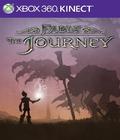Peter Molyneux has never been afraid to buck tradition. Even if his ideas haven't always panned out as described in the final product, the renowned designer constantly strived for the stars. When we sat down to take a look at his latest project, Fable: The Journey, it was immediately obvious that Molyneux's ambition hasn't diminished one iota.
Before launching into the demo, Molyneux took a moment to explain why he chose to focus on Kinect for this game. He told us that he wanted to return to the days of discovery for video games, where players could learn how to interact with the game through play, rather than simply being told to do X, then Y. According to Molyneux, he sees many games today as high-tech versions of pressing a button to get a reward. It's not so much entertainment in his eyes as repetitive, learned behavior.
That's exactly the sort of thing Molyneux wants to avoid with Fable: The Journey.
"We wanted to use Kinect [from the start]. Not for the obvious things, but rather the things you don't think about," said Molyneux. "Kinect is this undiscovered country."
While Kinect may be undiscovered country, the world in Fable: The Journey should be familiar to fans of the franchise. Running on the Unreal Engine 3 and set in the land of Albion, Fable: The Journey is set after Fable 3 but is not a direct sequel to that title. It is simply another story occurring in the same world.
Before the demo kicked off, Molyneux invited one of our group to take the reins. The only advice he gave was to act natural and to remember that Kinect cannot distinguish individual fingers. Everything else was fair game.
The first segment of the demo involved riding a horse and carriage down a path. Early on things were clear, but after a bit, some orc-like creatures arrived on rides of their own and started attacking.
Controlling your steed in Fable: The Journey is done by way of virtual reins. Pulling back on one or the other caused the horse to turn. Cracking the reins told the horse to pick up speed, while pulling back appeared to tell the horse to slow down. Learning how to control speed looked to be the best way to avoid incoming projectile attacks. Meanwhile, quick moves to the side seemed to be key to avoiding melee attacks.
After getting through the danger zone, our erstwhile hero stopped to treat the injured horse. The Kinect recognized hand gestures as arrows were pulled out of the horse's side. A magical glove was used to massage away the injured spots after the arrows were removed.
With the main character now on foot, the view shifted to a more traditional first-person style, and Molyneux explained that this was the part of the demo designed to show off the magic combat system. There was a quick set of flying enemies that were quickly dispatched with the flick of a hand, and a basic matching puzzle served as the lock for a door. Beyond the door was a boss fight.
Fighting the boss was a matter of dodging and using magic to attack. The left hand used a sort of magic whip while the right hand let loose with fire magic. Watching it unfold, the action appeared to be natural, with the on-screen character generally matching the actions of the player.
When it was all over, Molyneux took a moment to highlight a few options that the player missed. He explained that when using magic, it was possible to combine the spell types simply by moving one hand into another. More interesting, though, was the voice support. Although we did not see it used, Molyneux said that it was possible to use your voice to command the horse as well as to increase the power of your magic.
Interestingly enough, he said the magic power aspect wasn't tied to any specific words, but rather the intensity of your voice. A player who was yelling at the opponent would end up firing off stronger magic spells by default.
"Part of the joy of Fable: The Journey is discovering how to interact with the game," said Molyneux.
Given his stance on exploration, we asked if there were any plans to have an official strategy guide available for the game. After all, strategy guides usually give away everything; that's why players purchase them. Molyneux responded with the thought that he wouldn't have an issue with a map or a list of items, but he wouldn't want anyone telling players how to go about getting those items.
"I think [a strategy guide is] about what you can find in the game, not what you can do in the game," said Molyneux.
Assuming the game stays on schedule, you can plan on interacting with Fable: The Journey before the end of this year.
More articles about Fable: The Journey











 Fable: The Journey, powered by the latest Unreal Engine 3 tech, is poised to take the action-adventure series to new dimensions by fully using the Kinect technology.
Fable: The Journey, powered by the latest Unreal Engine 3 tech, is poised to take the action-adventure series to new dimensions by fully using the Kinect technology.









